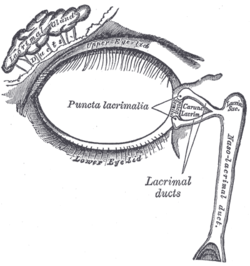Nasolacrimal duct
| Nasolacrimal duct | |
|---|---|
 | |
| The lacrimal apparatus. Right side. | |
 | |
| Outline of bones of face, showing position of air sinuses. | |
| Latin | d. nasolacrimalis |
| Gray's | subject #227 1029 |
| MeSH | Nasolacrimal+Duct |
The nasolacrimal duct (sometimes called the tear duct) carries tears from the lacrimal sac into the nasal cavity. The opening of the nasolacrimal duct into the inferior nasal meatus is partially covered by a mucosal fold (valve of Hasner or plica lacrimalis). Excess tears flow through nasolacrimal duct which drains into the inferior nasal meatus. This is the reason the nose starts to run when a person is crying or has watery eyes from an allergy, and why one can sometimes taste eye drops.
Like the lacrimal sac, the duct is lined by stratified columnar epithelium containing mucus-secreting goblet cells, and is surrounded by connective tissue.
Clinical Relevance
Obstruction of the nasolacrimal duct may occur.[1] leads to the excess overflow of tears called epiphora. A congenital obstruction can cause cystic expansion of the duct and is called a dacrocystocele or Timo cyst. Persons with dry eye conditions can be fitted with punctal plugs that seal the ducts to limit the amount of fluid drainage and retain moisture.
The canal containing the nasolacrimal duct is called the nasolacrimal canal.
In humans, the tear ducts in males tend to be larger than the ones in females.[2]
Additional images
-

Roof, floor, and lateral wall of left nasal cavity.
See also
- Congenital lacrimal duct obstruction
- Dacrocystocele
- Lacrimal apparatus
- Nasolacrimal duct obstruction
External links
- SUNY Figs 33:04-09
- lesson9 at The Anatomy Lesson by Wesley Norman (Georgetown University)
References
- ↑ Blocked tear ducts in infants, Pediatric Views, June 2006 http://www.childrenshospital.org/views/june06/blocked_tear_ducts.html
- ↑ Tears of Men and Women Are Different May 4, 2011, Wall Street Journal, mirrored at Why Men and Women Shed Different Tears by Fox News
| ||||||||||||||||||||